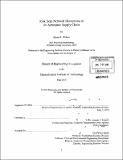| dc.contributor.advisor | Amanda J. Schmitt. | en_US |
| dc.contributor.author | Wilson, Bryan K. (Bryan Keith) | en_US |
| dc.contributor.other | Massachusetts Institute of Technology. Engineering Systems Division. | en_US |
| dc.date.accessioned | 2011-02-23T14:26:43Z | |
| dc.date.available | 2011-02-23T14:26:43Z | |
| dc.date.copyright | 2010 | en_US |
| dc.date.issued | 2010 | en_US |
| dc.identifier.uri | http://hdl.handle.net/1721.1/61189 | |
| dc.description | Thesis (M. Eng. in Logistics)--Massachusetts Institute of Technology, Engineering Systems Division, 2010. | en_US |
| dc.description | Cataloged from PDF version of thesis. | en_US |
| dc.description | Includes bibliographical references (p. 76-77). | en_US |
| dc.description.abstract | This thesis presents methods for determining the effects of risk from disruptions using an aerospace supply chain as the example, primarily through the use of a computer simulation model. Uncertainty in the current marketplace requires managers to be cognizant of the adverse impact of risk on their company's performance. However, managers who lack formal procedures for dealing with the potential impact of risk often are caught not knowing how much to invest in risk mitigation strategies. A computer simulation model representing a supply chain for a space vehicle was used to test different disruption scenarios to determine their impact on total production duration time. Scenarios ranging from suppliers not providing parts on time to quality test failures to disease pandemics were all considered. Randomness was incorporated through use of a stochasticity factor that was applied uniformly throughout the model. Output of the model was used to develop confidence percentiles for the complete duration times. Through testing of the various scenarios using the model we learned that most disruptions will add a deterministic time to the total estimated duration time of the system, regardless of the location of the disruption in the supply chain. In addition, we showed that a thorough review must be performed when choosing the stochasticity factor due to its large influence in determining total duration times and performance percentiles. The creation of the confidence percentiles allows the aerospace company to use the model throughout the entire 3 to 4 year production process to continually update and evaluate their buffer times and likelihood of meeting target completion dates. This buffer time can then be turned into a key performance index to better manage this supply chain. This model was created for a real supply chain, and it is currently being used by the aerospace company to help them plan and make appropriate decisions in regards to risk mitigation strategies in preparation for production of the space vehicle. They hope to expand the use of computer simulation models throughout the rest of their division to help drive down costs by increasing efficiencies in their planning. | en_US |
| dc.description.statementofresponsibility | by Bryan K. Wilson. | en_US |
| dc.format.extent | 77 p. | en_US |
| dc.language.iso | eng | en_US |
| dc.publisher | Massachusetts Institute of Technology | en_US |
| dc.rights | M.I.T. theses are protected by
copyright. They may be viewed from this source for any purpose, but
reproduction or distribution in any format is prohibited without written
permission. See provided URL for inquiries about permission. | en_US |
| dc.rights.uri | http://dspace.mit.edu/handle/1721.1/7582 | en_US |
| dc.subject | Engineering Systems Division. | en_US |
| dc.title | Risk from network disruptions in an aerospace supply chain | en_US |
| dc.type | Thesis | en_US |
| dc.description.degree | M.Eng.in Logistics | en_US |
| dc.contributor.department | Massachusetts Institute of Technology. Engineering Systems Division | |
| dc.identifier.oclc | 700945020 | en_US |
